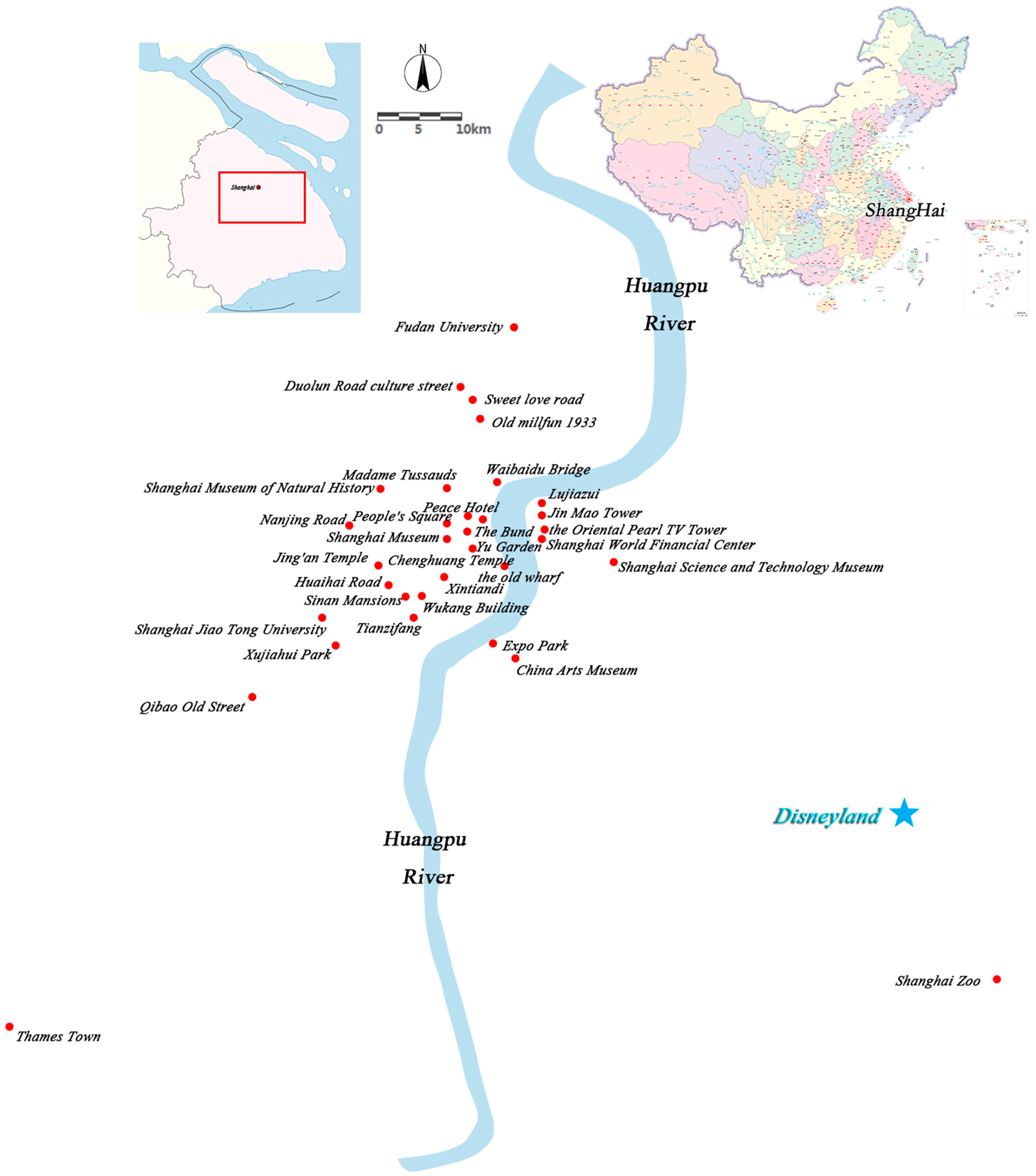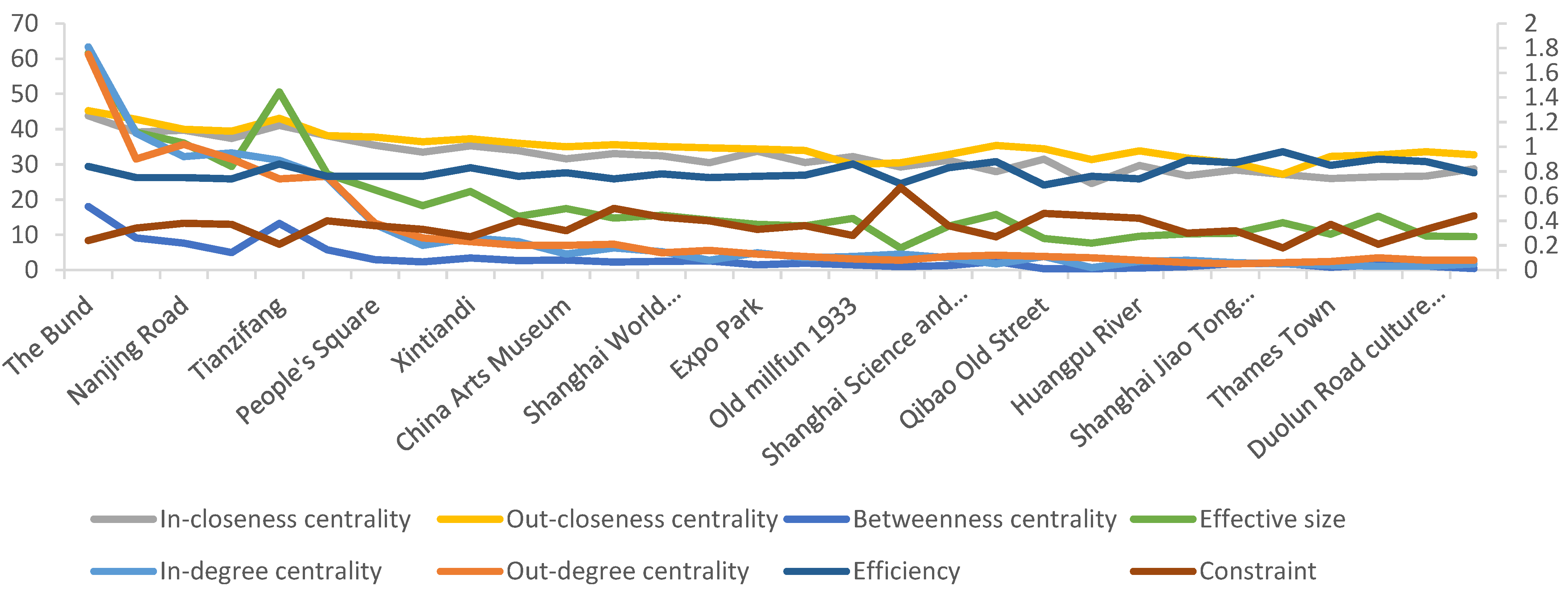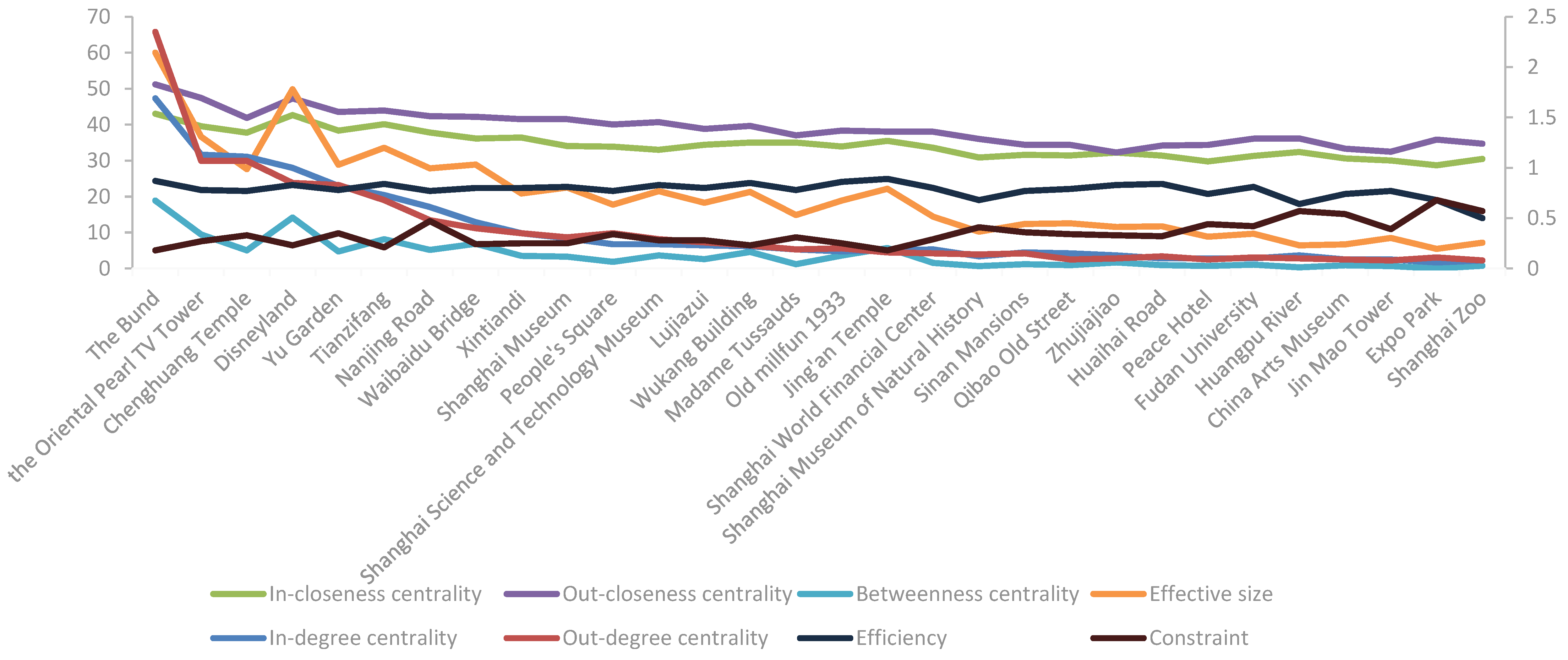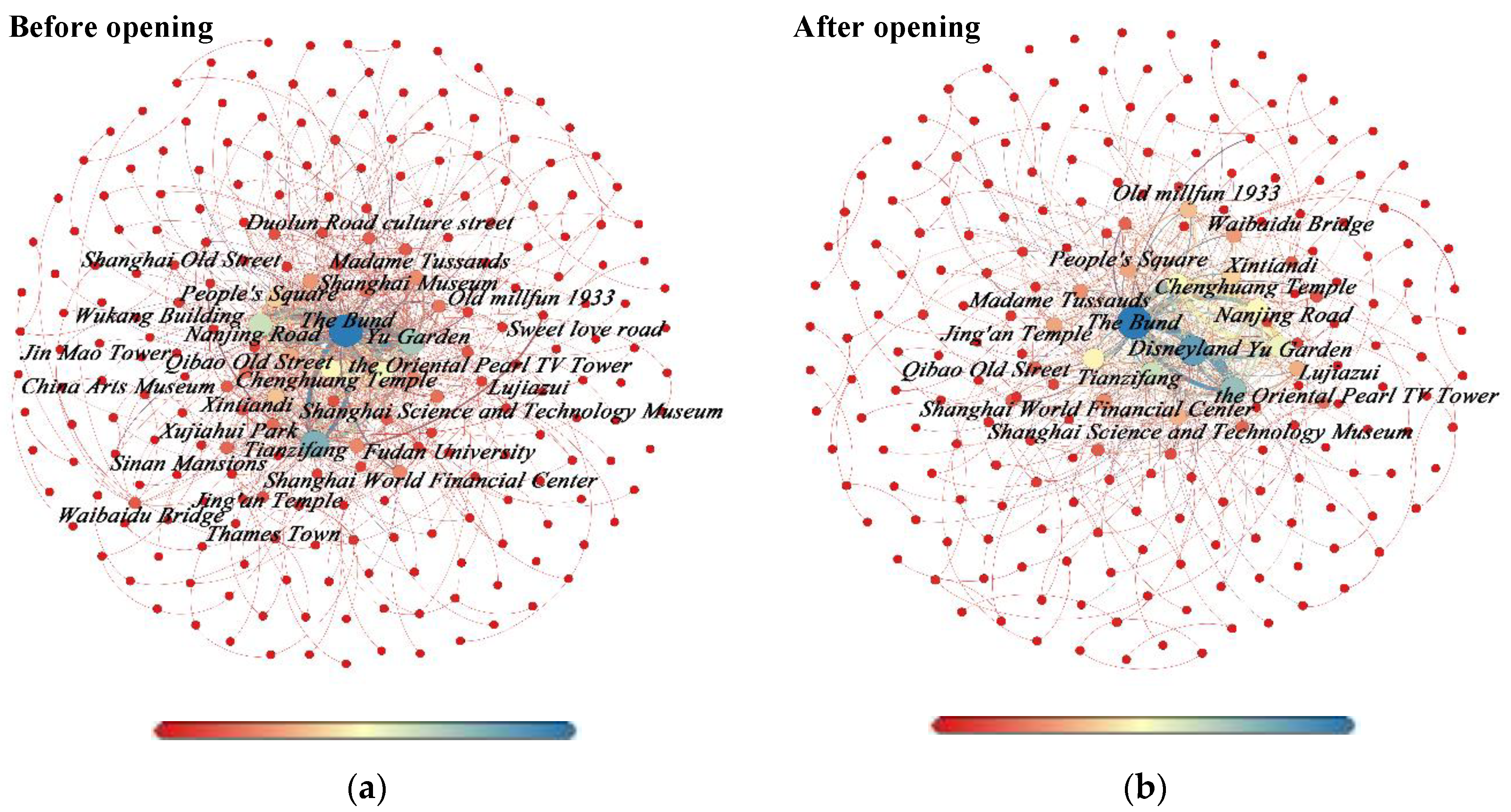Research on the Spatial Network Effect of Urban Tourism Flows from Shanghai Disneyland
Abstract
:1. Introduction
2. Literature Review
3. Methods
3.1. Network Node Analysis Method
3.1.1. Node Centrality
3.1.2. Closeness Centrality
3.1.3. Betweenness Centrality
3.1.4. Structural Holes
- (1)
- Effective size. Refers to the size of the individual network minus the redundancy of the network. The calculation formula is:where j represents all points connected to node i and q is every third party except i or j. piqmjq represents the redundancy between node i and a particular point j. ESi represents the effective size.
- (2)
- Efficiency. Refers to the ratio of the effective size of tourism nodes to the actual size.
- (3)
- Constraints. Reflects the degree to which a node directly and indirectly depends on other tourism nodes. The calculation formula is:where pij represents the proportion of ties with j to all ties of node i, piq represents the proportion of ties with q to all ties of node i, pqj represents the proportion of ties with j to all ties of node q, and Cij represents the constraint.
3.2. Network Node Analysis Method
3.2.1. Network Size
3.2.2. Network Density
3.2.3. Network Centralization
- (1)
- Degree centralization. This is the degree of network centrality calculated according to the method of degree centrality. The calculation formula is:where CRDmax is the maximum node centrality in the network, the numerator represents the sum of the differences between the centrality of all other nodes in the evaluated network and the maximum node centrality, and n is the number of tourism nodes in the tourism network. CRDi is the relative centrality, and CRD is the degree centralization.
- (2)
- Closeness centralization. This is the degree of network centrality calculated according to the method of closeness centrality. The calculation formula is:where C′RCmax is the maximum closeness centrality in the network and the numerator represents the sum of the differences between all other closeness centralities and the maximum closeness centralities in the evaluated network. C′RCi is the relative closeness centrality, and CC is the closeness centralization.
- (3)
- Betweenness centralization. This is the degree of network centrality calculated according to the method of betweenness centrality. The calculation formula is:where CRBmax is the maximum betweenness centrality in the network and the numerator represents the sum of the differences between all other betweenness centralities in the evaluated network and the maximum betweenness centralities. CRBi is the relative betweenness centrality, and CB is the betweenness centralization.
3.2.4. Core–Periphery Analysis
4. Data Selection and Sample Analysis
4.1. Data Selection
4.2. Sample Analysis
5. Analysis
5.1. Network Node Analysis
5.1.1. Analysis of Network Nodes before the Opening of Disneyland
5.1.2. Analysis of Network Nodes after the Opening of Disneyland
5.2. Overall Network Analysis
5.3. Analysis of Effects
5.3.1. Network Nuclear Overhauser Effect
5.3.2. Matthew Effect of Nodes
5.3.3. Combined Effects of Nodes
6. Discussion, Conclusion, and Policy Implications
6.1. Discussion
6.2. Conclusions
6.3. Policy Implications
Author Contributions
Funding
Institutional Review Board Statement
Informed Consent Statement
Data Availability Statement
Acknowledgments
Conflicts of Interest
References
- Robinson, K.; Burns, R. Proceedings of the 2006 Northeastern Recreation Research Symposium; Forest Service, Northern Research Station: New York, NY, USA, 2006; p. 23. [Google Scholar]
- Manning, R.E. Studies in Outdoor Recreation: Search and Research for Satisfaction, 3rd ed.; Oregon State University Press: Corvallis, OR, USA, 2011; pp. 412–468. [Google Scholar]
- Sung, N.-C. The Glocalization of Shanghai Disneyland; Routledge: London, UK, 2021. [Google Scholar] [CrossRef]
- Cheung, M.; McCarthy, W. “Authentically Disney, distinctly Chinese” and faintly American: The emotional branding of Disneyland in Shanghai. Semiotica 2019, 226, 107–133. [Google Scholar] [CrossRef] [Green Version]
- Mittermeier, S. A Cultural History of the Disneyland Theme Parks: Middle Class Kingdoms; Intellect Books: Bristol, UK, 2020. [Google Scholar]
- Li, Z.W.; Fang, G. The Lens to See the Construction of Organizational Identities: A Discursive Framework of Shanghai Disneyland. Int. J. Engl. Linguist. 2021, 11, 300. [Google Scholar] [CrossRef]
- Zhang, W.Y.; Zhu, L.; Zhang, Z.X.; Zhang, Z.; Lu, L.J. A Sustainable Evaluation Method for a Tourism Public Wayfinding System: A Case Study of Shanghai Disneyland Resort. Sustainability 2020, 12, 8489. [Google Scholar] [CrossRef]
- Jiang, Y.Y.; Liu, Y.X.; Wang, N.; Xu, H.B.; Gao, J.; Hong, P.F.; Fang, Y. The spatial dynamics of global inbound tourism network centrality during 2004–2019. Geogr. Res. 2022, 41, 698–712. [Google Scholar] [CrossRef]
- Prandi, C.; Nisi, V.; Ribeiro, M.; Nunes, N. Sensing and making sense of tourism flows and urban data to foster sustainability awareness: Areal-world experience. J. Big Data 2021, 8, 51. [Google Scholar] [CrossRef]
- Grama, C.N.; Baggio, R. A network analysis of Sibiu County, Romania. Ann. Tour. Res. 2014, 47, 89–93. [Google Scholar] [CrossRef] [Green Version]
- Zhu, H.; Liu, J.M.; Long, J.Z.; Yu, L.; Li, T. Urban tourism research in China and the United States based on a “space-theme” framework: Analysis of Ph.D. dissertations on urban tourism in 2008–2017. Prog. Geogr. 2019, 38, 1056–1068. [Google Scholar]
- Zheng, W.M.; Ji, H.P.; Lin, C.; Wang, W.H.; Yu, B. Using a heuristic approach to design personalized urban tourism itineraries with hotel selection. Tour Manag. 2020, 76, 103956.1–103956.14. [Google Scholar] [CrossRef]
- Boivin, M.; Tanguay, G.A. Analysis of the determinants of urban tourism attractiveness: The case of Québec City and Bordeaux. J. Destin. Mark. Manag. 2019, 11, 69–79. [Google Scholar] [CrossRef]
- Carlisle, S.; Johansen, A.; Kunc, M. Strategic foresight for (coastal) urban tourism market complexity: The case of Bournemouth. Tour Manag. 2016, 54, 81–95. [Google Scholar] [CrossRef]
- Ashworth, G.; Page, S.J. Urban tourism research: Recent progress and current paradoxes. Tour Manag. 2011, 32, 1–15. [Google Scholar] [CrossRef]
- Christaller, W. Some Considerations of Tourism Loca-tion in Europe: The Peripheral Regions-under-developed Countries-recreation Areas. Pap. Reg. Sci. 1964, 12, 95–105. [Google Scholar] [CrossRef]
- Lundgren, J.O.J. Tourist Impact/Island Entrepreneurship in the Caribbean; Conference of Latin Americanist Geographers; University of Texas Press: Austin, TX, USA, 1975; pp. 12–19. [Google Scholar]
- Haggett, P.; Chorley, R.J. Network Analysis in Geography; Edward Arnold: London, UK, 1969; pp. 54–55. [Google Scholar]
- Gregoryd, D.; Johnston, R.; Pratt, G. The Dictionary of Human Geography; Blackwell: Oxford, UK, 2011; pp. 76–79. [Google Scholar]
- Gunn, C.A.; Var, T. Tourism Planning; Taylor & Francis: New York, NY, USA, 1988; pp. 122–123. [Google Scholar]
- Chan, L.Y.; Lin, H.L.; Wang, C.L. Industry-region Position and Economic Performance of Travel and Tourism Service Industry: An Agglomeration Perspective. Asia Pac. J. Tour. Res. 2012, 17, 562–576. [Google Scholar] [CrossRef]
- Li, S.H.; Feng, B.Y. The research progress of agglomeration economic theory on foreign spatial economics: Research on the progress of urban agglomeration economics. Econ. Probl. 2008, 342, 15–21. [Google Scholar] [CrossRef]
- Tang, M.G.; Luo, M.L.; Wei, L.; Li, L.; Qin, Z.H. Identification of Chengdu’s leisure and entertainment hotspots based on POI data. Resour. Dev. Mark. 2018, 34, 1191–1195. [Google Scholar] [CrossRef]
- Xu, D.; Huang, Z.F.; Lv, L.; Chen, X.Y.; Cao, F.D. Research on spatial characteristics of urban leisure tourism based on POI mining: A case study of Nanjing city. Geogr. Geo-Inf. Sci. 2018, 34, 59–64. [Google Scholar]
- Tahir, A.; Aslıhan, D.C.; Meltem, C.; Lawrence, H.N.F. Big data use in determining competitive position: The case of theme parks in Hong Kong. J. Destin. Mark. Manag. 2021, 22, 100668. [Google Scholar]
- Todd, G. Impacts of COVID-related capacity constraints on theme park attendance: Evidence from Magic Kingdom wait times. Appl. Econ. Lett. 2020, 28, 14. [Google Scholar] [CrossRef]
- Salamiah, A.J.; Norliza, A.; Norliza, A.R. Visitors’ Experiences of Cluster Developments at Theme Parks in Malaysia. Asian Soc. Sci. 2017, 13, 41–48. [Google Scholar] [CrossRef] [Green Version]
- Fotiadis, A.K.; Vassiliadis, C.A. Service Quality at Theme Parks. J. Qual. Assur. Hosp. Tour. 2016, 17, 178–190. [Google Scholar] [CrossRef]
- Kuang, H.Y.; Jiang, R.C. Theme Park Resources and Memorable Tourism Experience. Econ. Manag. J. 2019, 1, 137–155. [Google Scholar] [CrossRef]
- Li, Y.W. Theme park: Its impactson regional economy and its own construction and development. Econ. Geogr. 2005, 25, 694–697. [Google Scholar]
- Duan, X.; Chan, C.S.; Marafa, L.M. Does authenticity exist in cultural theme parks? A case study of Millennium city park in Henan, China. J. Tour. Cult. Chang. 2019, 17, 321–338. [Google Scholar] [CrossRef]
- Shinde, K.A. Religious theme parks as tourist attraction systems. J. Herit. Tour. 2021, 16, 281–299. [Google Scholar] [CrossRef]
- Zuo, B.; Lu, J.M. An Empirical Study on the Factors Influencing the Location of Theme Parks in China. Trop. Geogr. 2018, 38, 781–790. [Google Scholar] [CrossRef]
- Dong, G.Z. Trend and stratagem of the evolvement on theme park. Hum. Geogr. 2005, 20, 43–46. [Google Scholar]
- Lu, S.; Yang, X.Z.; Tang, W.Y. On the Tourist Impact of Urban Residents’ Perceptions and Attitude on the Mega Theme Parks: A Case Study of Fantaworld Adventure in Wuhu City. Tour. Trib. 2011, 26, 45–52. [Google Scholar]
- Zhang, T.T.; Wang, C.Y.; Zhang, J.L. On the Relationship between Theme Park’s Constructions and Regional Economy: A Case of Disney Theme Park. Mod. Urban Res. 2010, 25, 85–90. [Google Scholar] [CrossRef]
- Liang, Z.X. Theme Park Development and Mangement; Chongqing University Press: Chongqing, China, 2019; pp. 126–211. [Google Scholar]
- Zhang, Y.S.; Li, X.; Su, Q.; Hu, X.B. Exploring a theme park’s tourism carrying capacity: A demand-side analysis. Tour. Manag. 2017, 59, 564–578. [Google Scholar] [CrossRef]
- Xiao, N.; Huang, Y.; Liu, J.S. Evaluation and spatial differentiation of tourism experience quality of theme park in China. Sci. Geogr. Sin. 2019, 39, 978–986. [Google Scholar] [CrossRef]
- Bendle, L.J. The structures and flows of a large tourist itinerancy network. Curr. Issues Tour. 2018, 21, 103–122. [Google Scholar] [CrossRef]
- Lozano, S.; Gutierrez, E. A complex network analysis of global tourism flows. Int. J. Tour. Res. 2018, 20, 588–604. [Google Scholar] [CrossRef]
- Hossein, R.; Rodolfo, B.; Llandis, B.P.; Gregory, W. Hyperlink Network Analysis of a Tourism Destination. J. Travel Res. 2017, 57, 671–686. [Google Scholar] [CrossRef] [Green Version]
- Mou, N.X.; Yuan, R.Z.; Yang, T.F.; Zhang, H.C.; Tang, J.W.; Teemu, M. Exploring spatio-temporal changes of city inbound tourism flow: The case of Shanghai, China. Tour Manag. 2020, 76, 151–164. [Google Scholar] [CrossRef]
- Shih, H.Y. Network characteristics of drive tourism destinations: An application of network analysis in tourism. Tour Manag. 2005, 27, 1029–1039. [Google Scholar] [CrossRef]
- Liu, P.; Zhang, H.; Zhang, J.; Sun, Y.; Qiu, M.Y. Spatial-temporal response patterns of tourist flow under impulse pre-trip information search: From online to arrival. Tour Manag. 2019, 73, 105–114. [Google Scholar] [CrossRef]
- Lin, L.; Kang, Z.L.; Gan, M.Y.; Ye, J.Y. An analysis of the spatial field effects of tourist flow of Taiwanese visiting Mainland China based on airports. Geogr. Res. 2007, 26, 403–413. [Google Scholar] [CrossRef]
- Zeng, B.; He, Y. Factors influencing Chinese tourist flow in Japan-a grounded theory approach. Asia Pac. J. Tour. Res. 2019, 24, 56–69. [Google Scholar] [CrossRef]
- Accetturo, A.; Cascarano, M.; Degasperi, P.; Modena, F. The effects of common culture and language on economic exchanges: Vi-dence from tourist flows. Reg. Stud. 2019, 53, 1575–1590. [Google Scholar] [CrossRef]
- Zhang, Z.; Bao, J.G. Effects of multiple distances on inbound and outbound tourism flows in China: A configuration-based perspective. Sci. Geogr. Sin. 2021, 41, 13–21. [Google Scholar] [CrossRef]
- Balli, F.; Balli, H.O.; Cebeci, K. Impacts of exported Turkish soap operas and visa-free entry on inbound tourism to Turkey. Tour Manag. 2013, 37, 186–192. [Google Scholar] [CrossRef]
- Khalid, U.; Okafor, L.E.; Burzynska, K. Do regional trade agreements enhance international tourism flows? Evidence from a cross-country analysis. J. Travel Res. 2021, 61, 1391–1408. [Google Scholar] [CrossRef]
- Liu, D.J.; Chen, J.Z.; Jia, Y.Y. Characteristic of tourist flow network in Chengdu-Chongqing urban agglomeration under the influence of high-speed railway. World Reg. Stud. 2020, 29, 549–556. [Google Scholar] [CrossRef]
- Xu, D.; Huang, Z.F.; Huang, R. The spatial effects of haze on tourism flows of Chinese cities: Empirical research based on the spatial panel econometric model. Acta Geogr. Sin. 2019, 74, 814–830. [Google Scholar] [CrossRef]
- Liu, D.J.; Chen, J.Z.; Jia, Y.Y. Influence of Jiuzhaigou earthquake on the geographical distribution and flow of regional tourist flows. J. Arid. Land Res. Environ. 2020, 34, 1–208. [Google Scholar] [CrossRef]
- Liu, S.; Zhang, J.; Liu, P.X.; Xu, Y.F.; Xu, L.; Zhang, H.L. Discovering spatial patterns of tourist flow with multi-layer transport networks. Tour. Geogr. 2021, 23, 1–23. [Google Scholar] [CrossRef]
- Chung, M.G.; Herzberger, A.; Frank, K.A.; Liu, J.G. International tourism dynamics in a globalized world: A social network analysis approach. J. Travel Res. 2020, 59, 387–403. [Google Scholar] [CrossRef]
- Yan, S.S.; Jin, C. Spatial Network Structure of the City-Level Tourist Flow Based on Multisource Data: A Case Study of Luoyang. Econ. Geogr. 2019, 39, 31–240. [Google Scholar] [CrossRef]
- Wang, C.H.; Tang, C.S.; Qiao, H.H.; Zhang, W.; Xing, L.Y. Spatial Structure Characteristics of Rural Tourism Flow Based on Digital Footprint: Taking Huzhou City in Zhejiang Province for Example. Econ. Geogr. 2020, 40, 225–240. [Google Scholar] [CrossRef]
- Wang, L.C.; Yan, C.X.; Li, W. Research on Spatial-temporal Characteristics of Tourist Flow Based on Sina Microblog LBS Data: An Case Study of Lanzhou. Tour. Trib. 2017, 32, 94–105. [Google Scholar] [CrossRef]
- Liu, Y.W.; Liao, W. Spatial characteristics of the tourism flows in China: A study based on the Baidu index. ISPRS Int. J. Geo-Inf. 2021, 10, 378. [Google Scholar] [CrossRef]
- Choi, K.H.; KIM, I. Co-movement between tourist arrivals of inbound tourism markets in South Korea: Applying the dynamic copula method using secondary time series data. Sustainability 2021, 13, 1283. [Google Scholar] [CrossRef]
- Nistor, M.M.; Nicula, A.S. Application of GIS technology for tourism flow modelling in the United Kingdom. Geogr. Tech. 2021, 16, 1–12. [Google Scholar] [CrossRef]
- Chen, H.; Lu, L.; Zheng, S.T. The Spatial Network Structure of the Tourism Destinations in Urban Agglomerations Based on Tourist Flow: A Case Study of the Pearl River Delta. Acta Geogr. Sin. 2011, 66, 257–266. [Google Scholar] [CrossRef]
- Ju, S.L.; Tao, Z.M.; Lai, Z.Q.; Chen, H.; Xu, Z. Research on Network Structure Evolution of Domestic Tourist Flow System in Zhejiang Province. Geogr. Geo-Inf. Sci. 2015, 31, 91–97, 114. [Google Scholar] [CrossRef]
- Guo, X.M.; Li, W. The social network analysis of tourism economic ties in Yunnan province based on the tourist flow angle of view. Tour. Res. 2014, 6, 88–94. [Google Scholar] [CrossRef]
- Liu, J.S.; Ma, Y.F. The evolution and driving mechanism of the supply and demand coupling about tourism flow and destination system based on the genesis and system theory: Taking Xi’an as an example. Geogr. Res. 2017, 36, 1583–1600. [Google Scholar] [CrossRef]
- Zhou, L.; Wu, D.T.; Yu, H.; Wang, Y.M.; Ma, T.; Hu, C. Evolution of Urban Tourism Flow Network Structure Based on Network Travet al Notes: A Case Study of Beijing City. Sci. Geogr. Sin. 2020, 40, 298–307. [Google Scholar] [CrossRef]
- Yang, X.Z.; Gu, C.L.; Wang, Q. Urban Tourism Flow Network Structure Construction in Nanjing. Acta Geogr. Sin. 2007, 62, 609–620. [Google Scholar] [CrossRef]
- Yang, Z.; Liu, Y.T.; Qin, J.F.; Liu, B.; Wang, P.P.; Liu, S.J.; Xu, Z.Y. Spatial structure of tourist market and its influencing factors in the Yangtze River Delta theme parks: A case study of Shanghai Happy Valley, Changzhou Dinosaur Park and Wuhu Fangte. J. Nat. Resour. 2021, 36, 722–736. [Google Scholar] [CrossRef]
- Marcos, A.D.; Beatrice, D.H.; Claudia, G.N.; Nicola, P. Analysing domestic tourism flows at the provincial level in Spain by using spatial gravity models. Int. J. Tour. Res. 2020, 22, 403–415. [Google Scholar] [CrossRef]
- Hwayoon, S.; Yoonjae, N.; George, A.B. A social network analysis of international tourism flow. Qual. Quant. 2021, 55, 419–439. [Google Scholar] [CrossRef]
- Zha, X.L.; Xu, Y.C.; Lu, L.; Zhao, H.R. Geographical distribution and flows of Chinese visitors to Shanghai Disneyland. Tour. Trib. 2019, 34, 58–73. [Google Scholar] [CrossRef]
- Wei, H.Y.; Dai, Z.F.; Xu, X.; Feng, X.G. The Impact of Shanghai Disneyland on Shanghai’s Tourist Flow Network: From the Perspective of Tourists’ Digital Footprints on the Lvmama Website. Tour. Trib. 2018, 33, 33–45. [Google Scholar]





| Type | Ratio (%) | Type | Ratio (%) | ||
|---|---|---|---|---|---|
| Travel days | one-day trip | 26.54 | Companion | couple | 7.05 |
| two-day trip | 34.36 | parents | 8.48 | ||
| three-day trip | 22.90 | friends | 29.00 | ||
| other | 16.20 | child | 24.81 | ||
| Means of transportation | high-speed rail | 34.39 | alone | 19.41 | |
| airplane | 44.06 | lovers | 11.25 | ||
| train | 13.34 | City transportation | metro/bus | 88.96 | |
| vehicle | 2.20 | other | 11.04 | ||
| self-drive | 6.01 | ||||
| Source of tourists | In descending order: Jiangsu, Zhejiang, Beijing, Guangdong, Liaoning, Shandong, Fujian, Tianjin, Sichuan, Anhui, Hubei, Chongqing, Hunan, Hebei, Shaanxi, Jilin, Henan, Jiangxi, Yunnan, Heilongjiang, Shanxi, Gansu, Xinjiang, Hainan, Inner Mongolia, Guangxi, Guizhou, Tibet, Qinghai, Ningxia | ||||
| Before Opening | After Opening | |
|---|---|---|
| Degree centralization | 2.170% | 2.730% |
| In-degree centralization | 1.768% | 1.628% |
| Out-degree centralization | 1.708% | 2.296% |
| In-closeness centralization | 49.950% | 42.920% |
| Out-closeness centralization | 52.360% | 59.500% |
| Betweenness centralization | 17.010% | 18.820% |
| Ucinet6.0 Core–Peripheral Analysis | Gephi0.9.2 Degree (d) Filter Analysis | |||||
|---|---|---|---|---|---|---|
| Core Node | Peripheral Node | The First Layer (d ≥ 2) | The Second Layer (2 > d ≥ 1) | The Third Layer (1 > d ≥ 0.2) | The Fourth Layer (d < 0.2) | |
| Before opening | The Bund, the Oriental Pearl TV Tower, Yu Garden, Nanjing Road, Chenghuang Temple | other nodes | The Bund | the Oriental Pearl TV Tower, Nanjing Road, Chenghuang Temple, Tianzifang | Yu Garden, People’s Square, Shanghai Museum, Xintiandi, Madame Tussauds, China Arts Museum, Waibaidu Bridge, Shanghai World Financial Center, Lujiazui | other nodes |
| After opening | Disneyland, Chenghuang Temple, The Bund, Yu Garden, the Oriental Pearl TV Tower | other nodes | The Bund | Disneyland, the Oriental Pearl TV Tower, Chenghuang Temple, Yu Garden, Tianzifang, Nanjing Road | Waibaidu Bridge, Xintiandi, Shanghai Museum, People’s Square, Shanghai Science and Technology Museum, China Arts Museum, Wukang Building, Madame Tussauds, 1933 Old Millfun, Lujiazui, Shanghai World Financial Center, Shanghai Museum of Natural History, Sinan Mansions, Qibao Old Street, Zhujiajiao | other nodes |
Publisher’s Note: MDPI stays neutral with regard to jurisdictional claims in published maps and institutional affiliations. |
© 2022 by the authors. Licensee MDPI, Basel, Switzerland. This article is an open access article distributed under the terms and conditions of the Creative Commons Attribution (CC BY) license (https://creativecommons.org/licenses/by/4.0/).
Share and Cite
Chen, H.; Wang, M.; Zheng, S. Research on the Spatial Network Effect of Urban Tourism Flows from Shanghai Disneyland. Sustainability 2022, 14, 13973. https://doi.org/10.3390/su142113973
Chen H, Wang M, Zheng S. Research on the Spatial Network Effect of Urban Tourism Flows from Shanghai Disneyland. Sustainability. 2022; 14(21):13973. https://doi.org/10.3390/su142113973
Chicago/Turabian StyleChen, Hao, Min Wang, and Shanting Zheng. 2022. "Research on the Spatial Network Effect of Urban Tourism Flows from Shanghai Disneyland" Sustainability 14, no. 21: 13973. https://doi.org/10.3390/su142113973
APA StyleChen, H., Wang, M., & Zheng, S. (2022). Research on the Spatial Network Effect of Urban Tourism Flows from Shanghai Disneyland. Sustainability, 14(21), 13973. https://doi.org/10.3390/su142113973








